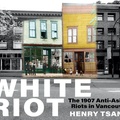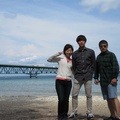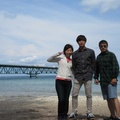Since I arrived in Japan a year ago, I’ve wanted to speak to Canadian Nikkei about their experience living here in Japan. I’ve met and talked with a couple who refused to be interviewed so I was especially pleased when Mr. Lloyd Hiroshi Kumagai contacted me after reading an article I’d written about aikido.
Mr. Kumagai, 65, is a Canadian nisei who was born in Burquitlam, B.C., on March 15, 1931. His parents, Takeshi and Masako (nee Sasaki), were both from Miyagi-ken and had a farm in Uwanuma, a village close to Towa-cho, the village where Jinsaburo Oikawa, one of the first Japanese immigrants to Canada, is from. Like many Japanese immigrants at the time, hard economic circumstances forced Takeshi towards making the decision to leave his wife and two young daughters, Hatsuko and Tomie, in Uwanuma.
The stories of Mr. Oikawa’s success in Canada that drifted to Uwanuma planted dreams of fortune in Takeshi’s own heart. The plan seemed like a good one. He was used to hard manual work that was required on a rice farm. Anyway, he was worried about his family’s future since his father, who enjoyed his sake and had married three or four times, had cost the family a substantial amount of property. Going to Canada seemed like a good way to get out of a bad situation, which threatened his family’s future. Takeshi Kumagai left for Canada full of hope, and sadness too since he knew it would be long time before he saw his family again.
After a long journey by ship, he reached Vancouver. By some advice, he ended up in Port Moody, B.C. landing a job as a mill hand at a sawmill. He worked hard to send money back to Japan to pay off debts and, hopefully before too long, to bring his wife to Canada to join him. It wasn’t until 1930, five years later, that Takeshi saw his wife again.
There weren’t many Nikkei families in Burquitlam. The Matsushitas, from Kumamoto, befriended Takeshi. He was thankful for the company and friendship of the Matsushitas. They owned a 12-acre farm where they grew strawberries, asparagus, raspberries, currants and raised some chickens. Land was cheap in those days, so Takeshi wanted to own land too.
Many of the first Japanese immigrants were good as ‘stoop labour’ because of their experience as rice farmers. It was back-breaking work nonetheless. Nikkei were scattered throughout the Lower Mainland of B.C. in places like New Westminster, Strawberry Hill, Lion’s Island. Some were settled in the Gulf Islands: Quardra, Salt Spring, Hornby, Gabriola, in Woodfibre and in Chemainus, Ucluelet and Victoria, but they were mostly in Vancouver where there was a thriving Japantown on Powell Street.
Hiroshi was born the following spring in the Matsushita’s home and was brought to Lily Matsushita’s bedside and slept there. Hiroshi as a four-year-old grew up like most other country kids. He attended Mountain View elementary school along with the children of other recent immigrants to Canada. His parents still spoke Japanese in the home, so he learned too. Every day after school, Hiroshi had to copy out ten times the kanji his mother left for him. She would check it when she returned from the fields to make supper.
It wasn’t until 1939 when his sister Hatsuko married in Uwanuma that Hiroshi first visited Japan. His father had been away for 15 years. They stayed for six months. Japan was at war with China then and even in Uwanuma they were sending young men off to war. They would receive an “aka gami ”(red letter) which told the conscripts to report for duty. Friends and neighbours carrying and waving flags would follow the young soldiers to the station. When the train came, the soldiers would get on and the crowd would shout “banzai” three times, each time raising their hands, and all through this the soldiers would salute.
Here is Hiroshi Kumagai, in his own words:
Mother used to tell me, if you go to Japan, the Japanese are much smarter than the Canadians; they dress better. In Canada you had one suit to wear all year round. In Japan they had summer, winter, spring and fall clothes and they were smarter! Mother used to say you’d never be able to compete in Japan because people are more clever. That’s what my mother used to say! I thought I wouldn’t want to live here. Everything was still behind.
At our farm we used to pack and send crates off east or to the Prairies. Some strawberries were bought by a Chinaman from New West-minister. He could read kanji, but he could communicate with my father because neither of them could speak English. Japan and China were fighting. They used to talk with each other in kanji about China, war, hope for peace. He used to have a car, we didn’t. Until the war started we were all the same. A lot of my school mates used to come and work on our farm, you see.
During the summer we were quite busy weeding and digging. My school friends could make a dollar, 50 cents or so. Sometimes you wanted to see a show or something, so they would come. Father or mother would say, ‘You pick the weeds from this end to the other and we’ll give you 10 cents or 20 cents.’ Everybody used to do that. They were all my friends and we used to hang around a lot, until the war started. Some didn’t like me and some still did. It wasn’t that they didn’t like me, but they’d say, ‘Well, you’re a Jap.’ There was no real racism before that. It was no body’s fault. It was because Japan bombed Pearl Harbor. A lot of guys used to feel sorry for me. Some used to say, ‘Kumagai, do you know what the Japs are doing in China?’ There were some guys like that around too. My parents were working on the farm all this time. They didn’t much contact with the outside world. I didn’t tell my parents about these things. They’d worry like hell. The teachers were good. They’d help me when I was being discriminated against.
I think school was on holiday when we were told to pack up and leave the farm. We were only given a couple of days or so. I remember packing up and nailing all the windows with boards. We went to Hastings Park in June. A big bus came to pick us up. The bus was a pretty big one. When we drove past the school there were all these friends of mine waving. We didn’t know when we were going to comeback. My parents thought this was going to be temporary. I used to deliver newspapers at the time. The guy who gave me the delivery route used to say a lot about Hastings Park. The Japanese are a rather clean race. They used to do a lot of cleaning. The hakujin used to say to me, ‘it looks like they’re going to have a hundred babies soon there was so much laundry!’ They shipped us to Slocan City where we lived in tents for a couple of months, then we were shipped to Lemon Creek. We spent four years there. By the war’s end I’d finished the fifth, sixth, seventh, and eighth grades. Father became sick with T.B. during our first winter in Lemon Creek. He was sent to the Sanitorium in New Denver where he died in 1943. Mother said ‘it was a good thing he died while Japan was still winning the war.’ His mind was on Japan only.
*The original story was written more than 10 years ago in the Toronto-based Nikkei Voice newspaper. Lloyd passed away in November 2004.
© 1996 Norm Ibuki






